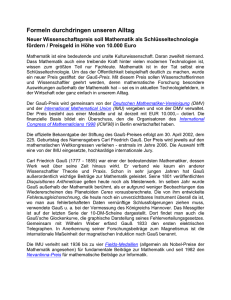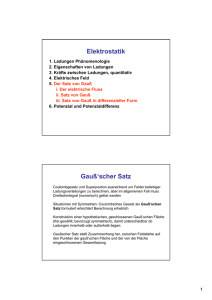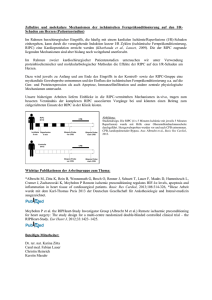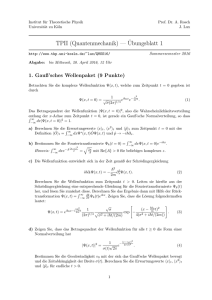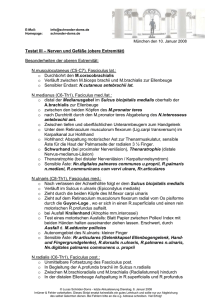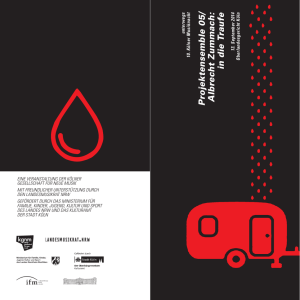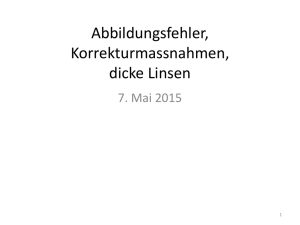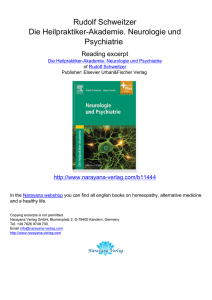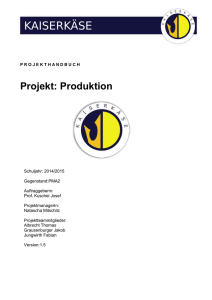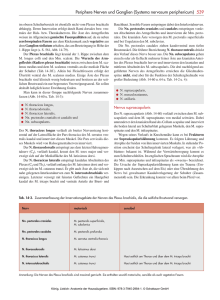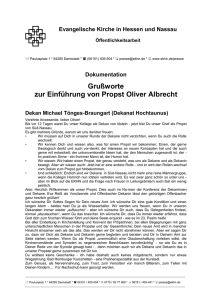N. radialis
Werbung
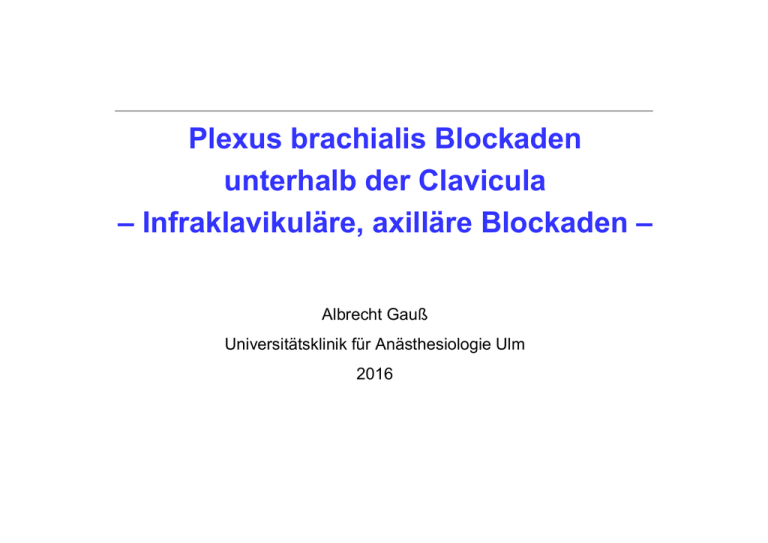
Plexus brachialis Blockaden unterhalb der Clavicula – Infraklavikuläre, axilläre Blockaden – Albrecht Gauß Universitätsklinik für Anästhesiologie Ulm 2016 Infraklavikuläre Plexusblockade Indikationen, Dosierung © Albrecht Gauß Indikationen • Operationen Unterarm, Handgelenk, Hand (v. a. Kinder) Ponde et al, Anesth Analg. 2009;108:1967–1970 • Operationen im Versorgungsgebiet des N. radialis (Radiusfraktur, Arthroskopie Handgelenk, OP DI-III) • Z. n. OP im Bereich der Axilla Dosierung • z. B. Prilocain 1% 30 ml + Mepivacain 1% 5–10 ml (insgesamt ca. 30–40 ml) Chin et al, Cochrane Database Syst Rev 2013 Aug 28;8:CD005487. doi: Infraklavikuläre Plexusblockade Komplikationen © Albrecht Gauß • Pneumothorax • ohne Ultraschall: ca. 0,2 – 0,7% (Neuburger et al, Anaesthesist 2000;49:901) • mit Ultraschall: ca. 0,07% (1:1.500) (Gauss et al, Anaesthesia 2014,69,327-36) Cave: asthenische, adipöse Patienten, Emphysem • Zwerchfellparese: ca. 3% komplette Parese mit Ultraschall (Petrar et al, Reg Anesth Pain Med 2015) Gefäßpunktion, LA-Intoxikation Nervenschaden: ca. 0,04% (Barrington et al, Reg Anesth Pain Med 2009;34:534–41) Dosis Bei Adipositas axilläre Plexusblockade vorziehen! Infraklavikuläre Plexusblockade in-plane von kranial (parasagittale = parakorakoidale Technik) Punktionsort: medial des Proc. coracoideus, direkt am Unterrand der Clavicula Proc. coracoideus Linearschallkopf 10-15 MHz Einstell-Tiefe ca. 4-5 cm 8 cm Nadel Ausnahme: Astheniker (5 cm) Vorteil: lateral von Claviculamitte © Albrecht Gauß Infraklavikuläre Plexusblockade Schematische Sono-Anatomie © Albrecht Gauß Fasciculus lateralis M. pectoralis major M. pectoralis minor • N. musculocutaneus • N. medianus-Anteil V. A. M subcl. subcl. L kranial P Fasciculus posterior • N. radialis • N. axillaris Variationen! (Sauter et al, Anesth Analg 2006; 103:1574-76) kaudal M Fasciculus medialis • N. medianus-Anteil • N. ulnaris • N. cut. brachii medialis • N. cut. antebrachii medialis Infraklavikuläre Plexusblockade in-plane von kranial: sonographisches Bild © Albrecht Gauß Fasciculus lateralis meist sichtbar (hyperechogen) Arterie Vene Infraklavikuläre Plexusblockade in-plane von kranial: sonographisches Bild M. pectoralis major Fasciculus lateralis M. pectoralis minor Fasciculus posterior © Albrecht Gauß Fasciculus medialis Infraklavikuläre Plexusblockade in-plane von kranial: Nadelführung kranial kaudal © Albrecht Gauß Infraklavikuläre Plexusblockade in-plane von kranial Praxis: mind. Doppelinjektion 6:00 + 9:00 ratsam (z.B. speziell bei Radiusfraktur: cave: N. cut. antebr. lat.) Nadel 9:00 L P Good signs U-förmige Ausbreitung Arterie nach kranial/medial Double bubble sign M 6:00 © Albrecht Gauß Axilläre Plexusblockade Indikationen, Vorteile, Dosierung Indikation: Operationen an Unterarm, Handgelenk, Hand Spezielle Indikationen, Vorteile • Adipositas, Schrittmacher/Katheter periclaviculär, COPD, Asthma bronchiale, kontralaterale Phrenikusparese Palmar Dorsal • Operationen am 5. Finger 31/2 21/2 • Karpaltunnelsyndrom 9 N. ulnaris 10 N. medianus • Unter Antikoagulation möglich (Blutung kontrollierbar) • Keine Pneumothoraxgefahr Dosierung: © Albrecht Gauß z. B. Prilocain 1% 30 ml + Mepivacain 1% 5–10 ml (insges. 30–40 ml) Axilläre Plexusblockade Nachteile (i. Vgl zu supra-, infrakl. Block) • Plexushülle? • Septen (Cornish et al, Anesthesiology 2006, Anesth Analg 2007) • „axillary tunnel“ → eher longitudinale Ausbreitung • Mäßige Erfolgsquote (70–85%) bei Einzelinjektion ohne Ultraschall Multiinjektionstechnik (Cochrane Database Syst Rev. 2013 Aug 8;8:CD003842. doi:) • Problemnerven N. cutaneus brachii, antebrachii medialis N. radialis, N. musculocutaneus N. intercostobrachialis (Th 2) © Albrecht Gauß • Großlumige Venen v. a. um N. ulnaris (höheres LA-Intoxikationsrisiko?) • Höhere Infektionsrate bei Katheteranlage (?) (Neuburger et al Acta Anesth Scand 2007;51:108-14: Inzidenz Infektion 3,8%, Drainage 1%) • Zeitaufwand (?): längere Dauer für sonogr. Blockanlage (mind. 4 Nerven!) inkl. Tracing im Vgl. zu infra-, supraclaviculärem Block (Tran et al, RAPM 2009) Plexus axillaris (C 5 – Th1) Anatomie (Darstellung rechte Axilla) M. biceps M. coracobrachialis kaudal kranial N. medianus kranial N. ulnaris kaudal A. axillaris V. axillaris posterior M. triceps N. musculocutaneus N. radialis posterior Axilläre Plexusblockade Sonographie Axilla (kurze Achse) N. medianus N. ulnaris © Albrecht Gauß A. axillaris M.biceps biceps N. radialis (begleitet von A. prof. brachii) M. coracobrachialis M. triceps / M. teres major N. musculocutaneus N. medianus N. ulnaris A. axillaris Beachte: Venen komprimierbar Trick: „Nerve tracing“ „Hydrolocation“ N. radialis N. musculocutaneus Axilläre Plexusblockade Ultraschallanlotung out of plane • SAX (Querschnitt Nerv)) • out of plane (Querschnitt Nadel) © Albrecht Gauß Linearschallkopf 12-15 MHz Bildtiefe 1-2 cm Praxis: 5 cm Nadel Axilläre Plexusblockade Ultraschallanlotung in plane von kaudal • SAX (Querschnitt Nerv)) • in plane (Längsschnitt Nadel) © Gernot Gorsewski Axilläre Plexusblockade Praxis der ultraschallgesteuerten Blockade Alle 4 Nerven lokalisieren u. blockieren (perineurale Blockkade) Zur Verhinderung intravasaler-, intraneuraler Injektionen • • • • • Ggf. per Doppler Venen lokalisieren Venen mit Transducer komprimieren Aspiration Langsame Injektion von 0,5–1 ml LA Ausbreitung und Injektionsdruck beobachten © Albrecht Gauß Gorsewski Axilläre Plexusblockade Sono-Anatomie Axilla – Variationen Nervenlokalisation bei ca. 2/3 der Patienten M U MC R © Albrecht Gauß Christophe et al, Br J Anaesth 2009;103:606-12 Bei 20% der Patienten 2 oder mehr Nerven sonographisch nicht abgrenzbar! Axilläre Plexusblockade Lage der Nerven in Bezug auf A. axillaris abhängig von: • Höhe der Anschallung in der Axilla • Flexion, Extension, Rotation des Armes • Druck auf die Strukturen • Injektion von Flüssigkeiten inkl. LA © Albrecht Gauß N. radialis Tracing von distal (Mitte OA) nach proximal beginnend Mitte OA N. radialis © Albrecht Gauß Sonographische Landmarke für N. radialis Conjoint tendon (Gray AT Reg Anesth Pain Med 2009, 34: 179) A N. radialis © Albrecht Gauß Conjoint tendon: M. lattisimus dorsi, M. teres major Axilläre Plexusblockade - Vergleich Ultraschall vs. Nervenstimulation Chan et al, Can J Anaesth 2007;54:165-70 (prospektiv, randomisiert) US n = 64 NS n = 62 9 min* 11 min 83%* 63% 95% 86% N. medianus 94% 82% N. ulnaris 97%* 83% N. radialis 86%* 69% Zeit für Blockanlage Kompletter sensorischer Block (alle 3 Nerven) Erfolgreiche chirurg. Anästhesie (ohne Supplementierung) NS: Nervenstimulation (Multiinjektion); US: Ultraschall; * = signifikant © Albrecht Gauß Urheberrechtlich geschützt (Copyright). Das Urheberrecht liegt, soweit nicht ausdrücklich anderes gekennzeichnet, bei Albrecht Gauß. Wer gegen das Urheberrecht verstößt, macht sich gem. §106 ff Urheberrecht… 16.03.2016 © Albrecht Gauß
